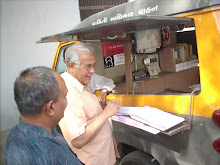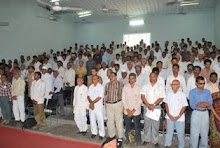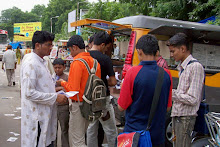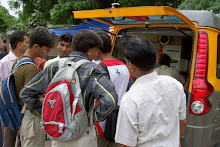The Hindu: Rajasthan: Friday, 17th October 2025.
In Beawar, Rajasthan, the birthplace of the Right to Information movement, people reckon with a looming setback while celebrating 20 years of a historic law. Aroon Deep finds that even as groups from across India gather to rejoice at the citizen wins, they protest its erosion in several ways, especially by the Digital Personal Data Protection Act, 2023
In the heart of Beawar,
activists and villagers gather late in the afternoon on October 11. They sit on
a carpet laid across a triangular section of road between the historic Chang
gate and the district’s moderately bustling market. The crowd chants in Hindi,
as volunteers hand out fliers for the words that have animated them for decades
“Hamara paisa, hamara hisab” (We will account for our money), “Hum jaanenge,
hum jeeyenge,” (We will know, we will live), and “Hum ladenge, hum jeetenge”
(We will fight, we will win).
Chang gate is historical, not just because villagers say the structure dates back to the colonial era, but also because of the 1996 protest held here. Then, at least 200 labourers and farmers called officials to “jan sunwayis” or people’s hearings, confronting them with demands of records for everything from land allotments to schoolhouse expenditure.
Officials had squirmed as it snowballed into a mass movement that year, with encouragement (and help in attracting national media attention to the cause) from activists like Aruna Roy and Nikhil Dey of the Mazdoor Kisan Shakti Sangathan (MKSS), a non-profit organisation. This kickstarted the campaign for transparency that resulted in the Right to Information Act (RTI), 2005. With this Act, an Indian citizen can put in an application to get any government information with the exception of issues pertaining to national security.
In time, this became a tool for activists and journalists to hold the government accountable. “We were pinching ourselves to make sure it was real,” Dey, MKSS’ co-founder says during the candle march, in a conversation frequently interrupted by long lost comrades-in-arms and panicked volunteers seeking instructions.
The event, to celebrate 20 years of the RTI Act, was also a call-out to its dilution, mainly with the Digital Personal Data Protection Act, 2023. It is a dilution that would make it harder for activists who pioneered the law to use it to the ends for which they had conceived of it.
Capped off with an RTI-themed Rajasthani-language skit, a folk song, and a candlelight march featuring an autorickshaw mounted with a rod puppet lip syncing to the slogans, the event is equal parts mobilisation and publicity. It is a pre-event for a Right to Information Mela (fair) scheduled the next day.
A citizens’ tool
In 1996, the year of the original demonstrations, Bhairon Singh Shekhawat, Rajasthan’s Chief Minister and a leader of the Bharatiya Janata Party, committed on the floor of the State’s legislature to open up local municipal records to public scrutiny. But Shekhawat’s commitment turned to equivocation the following day when the State government released the fine print: records would be available for inspection with a fee, and there would be no facility to photocopy them. Shekhawat would later argue that there weren’t enough resources to purchase photocopiers for the State’s myriad local government offices.
The MKSS and Beawar’s residents, along with volunteers from other parts of Rajasthan, turned up the pressure, holding a sit-in at Chang gate for 40 days. “When we woke up, we would find our slippers strewn around the area,” Roy recalls. “Pigs would pick them up and leave them somewhere else.” They called off the protest “in good faith,” a volunteer says, giving the government some breathing room to implement the activists’ demands.
It would be four years before Rajasthan passed a State-level RTI law, in 2000.
In government records,
Beawar’s RTI activists had found a potent tool for mobilisation and
accountability, long before the national law came into force. In 2001, Sushila
Devi found out that snakebite victims during Beawar’s unforgiving monsoon
season were being charged for anti-venom doses, when they were supposed to be
administered free of charge in government hospitals. Doctors were also charging
mothers ₹500 after childbirth, the records said.
“I took these records to the villages, and asked everyone who had received a dose or given birth, whether they had paid,” Devi, now 60, says. “They said they had.” Shortly after, hospital staff were confronted with the testimonials and the records, which showed no payment. “They didn’t give the money back, but said it wouldn’t happen anymore.”
This was a social audit, one of several conducted in Beawar and around the country after the RTI Act was enacted and implemented, allowing people the right to inspect everything from road construction contract terms to ration shop records. It amounted to a powerful tool in the struggle of ordinary citizens against India’s ubiquitous nexus between politics and money, which often ensures power.
The movement of people and ideas
It’s Sunday, the day of the mela. The event is being held at the spot where a museum will come up, dedicated to the history of the struggle to get the RTI Act passed and its consequent impact. Hundreds of people activists, volunteers, villagers who had benefited in one way or the other due to RTI requests in the past gather under a large white tent under the sun. Different stalls are set up by MKSS’s sister organisations from a people’s movement from Meghalaya to a thousands-strong RTI users’ group from Tamil Nadu, who took a two-day train journey from Madurai to attend the fair.
The Tamil Nadu delegation, 25 people in all, has a team T-shirt from an August gathering in Kallakurichi, which attracted 2,500 RTI users in the State. Bakiyaraj, an employee of the Tamil Nadu Electricity Board, speaks of how he used dozens of RTI applications to uncover irregularities in how the State issued birth and death certificates with ramifications for inheritance. “I made sure that people duly got death certificates with both parents’ names,” he says.
At one stall, a volunteer
explains the proactive disclosures section of the law, with a government
website’s statutorily required documents displayed on an LED TV. At another,
Gaurav Chaurotiya, a Beawar native currently working as a software engineer in
Noida, Uttar Pradesh, shows how land papers for a municipal rehabilitation were
held up for 10 years, eventually becoming available to beneficiaries.
“I was able to get my patta only two years ago, when I had applied 10 years prior,” says Geeta Devi, 62, who was among those Chaurotiya helped. Others were not so lucky: Sugni Devi was well into her 80s when she got her patta. After that, she faced issues getting funding under the Prime Minister’s house construction subsidy scheme, the PM Awas Yojana. While the press coverage documenting her struggle led to those funds getting cleared, she died at 84, shortly after the foundation stone was laid and before she could see the house she had fought to build.
Sandpapering over
The RTI Act hasn’t necessarily represented a full reckoning of political power in India and the unlawful means and ends it entails; that is perhaps too tall an order for a piece of legislation. Nevertheless, the structures it created and the rights it wrote into the statute books were a surprise even for those who spent over a decade fighting for it.
Was there a golden era for the RTI Act? “Right after it was passed,” Dey says, as the fear of penalties and blemishes to service records and becoming a target of people-led mobilisations kept public information officers from being too evasive.
Those days seem distant now. In 2019, Parliament amended the RTI Act, with the Union government seizing powers over the tenure and salaries of Information Commissioners. Information Commissioners are appellate posts, both at the Centre and State. People who are dissatisfied with answers to RTI applications can appeal to them, and if still not satisfied, can approach the High Court.
Jammu and Kashmir’s
setback is steeper. Before the abrogation of Article 370 of the Constitution,
the erstwhile State’s special status allowed it to have its own RTI Act, one
that Irfan Banka, a PhD scholar running a booth at the mela, says was better than
the Central Act. “Now, every appeal goes to the Central Information Commission
(CIC),” as that’s where Union Territories’ RTI appeals go. The quality of
responses has reduced too, he adds.
Appellants refer to recent experiences at the CIC, with emotions varying from disappointment to indignation. In the last four years, it is not an unusual sight to see the commissioner hearing a case pushing back on an appellant’s arguments, and passing an order that maintains the status quo, without the government representative saying much, they say.
Even if the commissions’ allegiance to power doesn’t outweigh the public’s right to know, pendency comes to reluctant government organisations’ aid: cases at the CIC take more than a year to be heard, and that timeline is set to expand. Heeralal Samariya, the most recent Chief Information Commissioner, demitted office on September 14, and the government only put out a call for applications for his successor afterward, even though the end of his term was known widely.
Samariya’s vacancy is just the tip of the iceberg: the CIC has 11 posts, of which 9 lie vacant. A similar dynamic is playing out across the country with occasionally more extreme lapses. In 2024, six State Information Commissions (SICs) had no commissioners to hear cases, though staff helplessly catalogued new appeals with no idea of if and when they will ever be heard. The Supreme Court has called on State governments to fill these vacancies but those instructions are yet to be carried out in full, according to a review by the National Campaign for People’s Right to Information (NCPRI), where Dey is a co-convenor.
But the most stinging setback has been a 2023 amendment, buried in the final part of the Digital Personal Data Protection Act, 2023. That law’s main goal is to penalize firms that don’t protect user data from being leaked, and to ensure that people have choices on how their data is used online. At the same time, activists have argued, it deals a body blow to the RTI Act.
Section 8(1)(j) of the data protection Act allows any government organisation to decline “information which relates to personal information”. It goes on to specify that there must be “larger public interest” to justify the release of such information. Legal experts say the 2023 Act broadens the scope of ‘personal information’ or information that may not be disclosed.
The government has argued that this amendment is simply implementing the Supreme Court’s 2017 right to privacy judgment, and that information whose disclosure is statutorily otherwise required will be published. The activists aren’t convinced: if it comes to pass, the social audits like those led by Sushila Devi and Gaurav Chaurotiya would become simply impossible, they argue.
The amendment has not yet kicked in, as the 2023 Act gave the government the power to “notify” when it comes into effect. So far, there have been no indications that the Ministry of Electronics and Information Technology, which has the power to enforce different sections of the law at different times, is willing to hold off on enforcing the amendment to Section 8(1)(j).
The road ahead is uncertain. “We don’t know what form the resistance will take when the 2023 Act kicks in,” Roy says. “But we won’t take it lying down.”
Speaking on the sidelines of the mela, Justice A.P. Shah, who wrote a strongly worded legal opinion that argued against the amendment, said that there was “good scope” for activists to have a legal case against it. With a view to all that has been accomplished and all that is at stake, Dey nevertheless strikes an optimistic note: “This,” he says gesturing at the buzzing mela, “is a movement with a life of its own. An amendment can’t stop it.”
aroon.deep@thehindu.co.in
Edited by Sunalini Mathew
In Beawar, Rajasthan, the birthplace of the Right to Information movement, people reckon with a looming setback while celebrating 20 years of a historic law. Aroon Deep finds that even as groups from across India gather to rejoice at the citizen wins, they protest its erosion in several ways, especially by the Digital Personal Data Protection Act, 2023
 |
| Workers during the laying of the foundation of the National RTI Museum in Beawar, Rajasthan. Hundreds had gathered there to celebrate the RTI movement Photo Credit: Sushil Kumar Verma |
Chang gate is historical, not just because villagers say the structure dates back to the colonial era, but also because of the 1996 protest held here. Then, at least 200 labourers and farmers called officials to “jan sunwayis” or people’s hearings, confronting them with demands of records for everything from land allotments to schoolhouse expenditure.
Officials had squirmed as it snowballed into a mass movement that year, with encouragement (and help in attracting national media attention to the cause) from activists like Aruna Roy and Nikhil Dey of the Mazdoor Kisan Shakti Sangathan (MKSS), a non-profit organisation. This kickstarted the campaign for transparency that resulted in the Right to Information Act (RTI), 2005. With this Act, an Indian citizen can put in an application to get any government information with the exception of issues pertaining to national security.
In time, this became a tool for activists and journalists to hold the government accountable. “We were pinching ourselves to make sure it was real,” Dey, MKSS’ co-founder says during the candle march, in a conversation frequently interrupted by long lost comrades-in-arms and panicked volunteers seeking instructions.
The event, to celebrate 20 years of the RTI Act, was also a call-out to its dilution, mainly with the Digital Personal Data Protection Act, 2023. It is a dilution that would make it harder for activists who pioneered the law to use it to the ends for which they had conceived of it.
Capped off with an RTI-themed Rajasthani-language skit, a folk song, and a candlelight march featuring an autorickshaw mounted with a rod puppet lip syncing to the slogans, the event is equal parts mobilisation and publicity. It is a pre-event for a Right to Information Mela (fair) scheduled the next day.
A citizens’ tool
In 1996, the year of the original demonstrations, Bhairon Singh Shekhawat, Rajasthan’s Chief Minister and a leader of the Bharatiya Janata Party, committed on the floor of the State’s legislature to open up local municipal records to public scrutiny. But Shekhawat’s commitment turned to equivocation the following day when the State government released the fine print: records would be available for inspection with a fee, and there would be no facility to photocopy them. Shekhawat would later argue that there weren’t enough resources to purchase photocopiers for the State’s myriad local government offices.
The MKSS and Beawar’s residents, along with volunteers from other parts of Rajasthan, turned up the pressure, holding a sit-in at Chang gate for 40 days. “When we woke up, we would find our slippers strewn around the area,” Roy recalls. “Pigs would pick them up and leave them somewhere else.” They called off the protest “in good faith,” a volunteer says, giving the government some breathing room to implement the activists’ demands.
It would be four years before Rajasthan passed a State-level RTI law, in 2000.
 |
| An RTI worker at Chang gate in Beawar, Rajasthan, a day before the National RTI Mela on October 12. | Photo Credit: SUSHIL KUMAR VERMA |
“I took these records to the villages, and asked everyone who had received a dose or given birth, whether they had paid,” Devi, now 60, says. “They said they had.” Shortly after, hospital staff were confronted with the testimonials and the records, which showed no payment. “They didn’t give the money back, but said it wouldn’t happen anymore.”
This was a social audit, one of several conducted in Beawar and around the country after the RTI Act was enacted and implemented, allowing people the right to inspect everything from road construction contract terms to ration shop records. It amounted to a powerful tool in the struggle of ordinary citizens against India’s ubiquitous nexus between politics and money, which often ensures power.
The movement of people and ideas
It’s Sunday, the day of the mela. The event is being held at the spot where a museum will come up, dedicated to the history of the struggle to get the RTI Act passed and its consequent impact. Hundreds of people activists, volunteers, villagers who had benefited in one way or the other due to RTI requests in the past gather under a large white tent under the sun. Different stalls are set up by MKSS’s sister organisations from a people’s movement from Meghalaya to a thousands-strong RTI users’ group from Tamil Nadu, who took a two-day train journey from Madurai to attend the fair.
The Tamil Nadu delegation, 25 people in all, has a team T-shirt from an August gathering in Kallakurichi, which attracted 2,500 RTI users in the State. Bakiyaraj, an employee of the Tamil Nadu Electricity Board, speaks of how he used dozens of RTI applications to uncover irregularities in how the State issued birth and death certificates with ramifications for inheritance. “I made sure that people duly got death certificates with both parents’ names,” he says.
 |
| A museum dedicated to the history of the law and the people’s movement that helped bring it into force will be come up at Beawar. |Photo Credit: SUSHIL KUMAR |
“I was able to get my patta only two years ago, when I had applied 10 years prior,” says Geeta Devi, 62, who was among those Chaurotiya helped. Others were not so lucky: Sugni Devi was well into her 80s when she got her patta. After that, she faced issues getting funding under the Prime Minister’s house construction subsidy scheme, the PM Awas Yojana. While the press coverage documenting her struggle led to those funds getting cleared, she died at 84, shortly after the foundation stone was laid and before she could see the house she had fought to build.
Sandpapering over
The RTI Act hasn’t necessarily represented a full reckoning of political power in India and the unlawful means and ends it entails; that is perhaps too tall an order for a piece of legislation. Nevertheless, the structures it created and the rights it wrote into the statute books were a surprise even for those who spent over a decade fighting for it.
Was there a golden era for the RTI Act? “Right after it was passed,” Dey says, as the fear of penalties and blemishes to service records and becoming a target of people-led mobilisations kept public information officers from being too evasive.
Those days seem distant now. In 2019, Parliament amended the RTI Act, with the Union government seizing powers over the tenure and salaries of Information Commissioners. Information Commissioners are appellate posts, both at the Centre and State. People who are dissatisfied with answers to RTI applications can appeal to them, and if still not satisfied, can approach the High Court.
 |
| Activists Aruna Roy and Nikhil Dey, leaders of the movement, in Beawar during the celebrations. | Photo Credit: SUSHIL KUMAR VERMA |
Appellants refer to recent experiences at the CIC, with emotions varying from disappointment to indignation. In the last four years, it is not an unusual sight to see the commissioner hearing a case pushing back on an appellant’s arguments, and passing an order that maintains the status quo, without the government representative saying much, they say.
Even if the commissions’ allegiance to power doesn’t outweigh the public’s right to know, pendency comes to reluctant government organisations’ aid: cases at the CIC take more than a year to be heard, and that timeline is set to expand. Heeralal Samariya, the most recent Chief Information Commissioner, demitted office on September 14, and the government only put out a call for applications for his successor afterward, even though the end of his term was known widely.
Samariya’s vacancy is just the tip of the iceberg: the CIC has 11 posts, of which 9 lie vacant. A similar dynamic is playing out across the country with occasionally more extreme lapses. In 2024, six State Information Commissions (SICs) had no commissioners to hear cases, though staff helplessly catalogued new appeals with no idea of if and when they will ever be heard. The Supreme Court has called on State governments to fill these vacancies but those instructions are yet to be carried out in full, according to a review by the National Campaign for People’s Right to Information (NCPRI), where Dey is a co-convenor.
But the most stinging setback has been a 2023 amendment, buried in the final part of the Digital Personal Data Protection Act, 2023. That law’s main goal is to penalize firms that don’t protect user data from being leaked, and to ensure that people have choices on how their data is used online. At the same time, activists have argued, it deals a body blow to the RTI Act.
Section 8(1)(j) of the data protection Act allows any government organisation to decline “information which relates to personal information”. It goes on to specify that there must be “larger public interest” to justify the release of such information. Legal experts say the 2023 Act broadens the scope of ‘personal information’ or information that may not be disclosed.
The government has argued that this amendment is simply implementing the Supreme Court’s 2017 right to privacy judgment, and that information whose disclosure is statutorily otherwise required will be published. The activists aren’t convinced: if it comes to pass, the social audits like those led by Sushila Devi and Gaurav Chaurotiya would become simply impossible, they argue.
The amendment has not yet kicked in, as the 2023 Act gave the government the power to “notify” when it comes into effect. So far, there have been no indications that the Ministry of Electronics and Information Technology, which has the power to enforce different sections of the law at different times, is willing to hold off on enforcing the amendment to Section 8(1)(j).
The road ahead is uncertain. “We don’t know what form the resistance will take when the 2023 Act kicks in,” Roy says. “But we won’t take it lying down.”
Speaking on the sidelines of the mela, Justice A.P. Shah, who wrote a strongly worded legal opinion that argued against the amendment, said that there was “good scope” for activists to have a legal case against it. With a view to all that has been accomplished and all that is at stake, Dey nevertheless strikes an optimistic note: “This,” he says gesturing at the buzzing mela, “is a movement with a life of its own. An amendment can’t stop it.”
aroon.deep@thehindu.co.in
Edited by Sunalini Mathew














































































